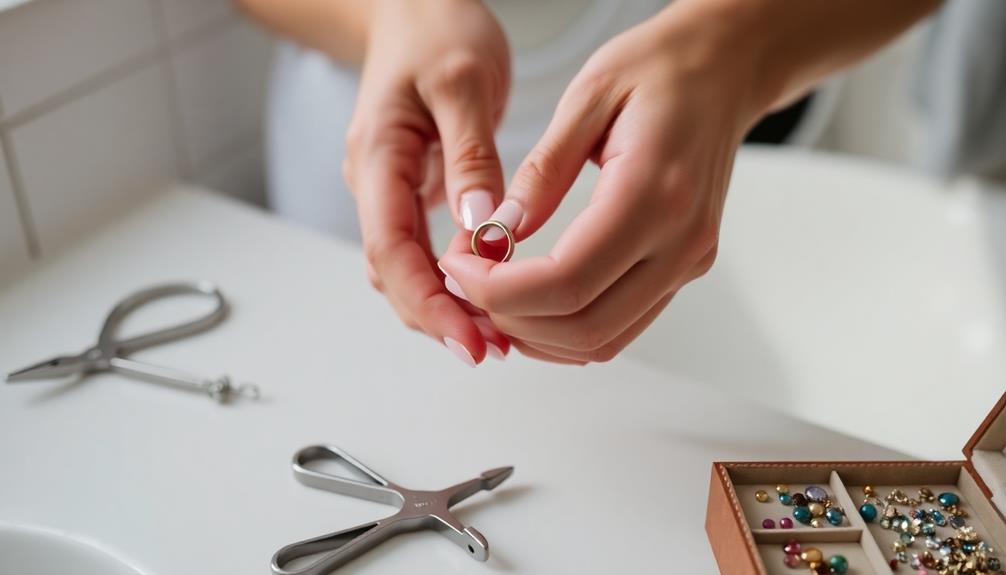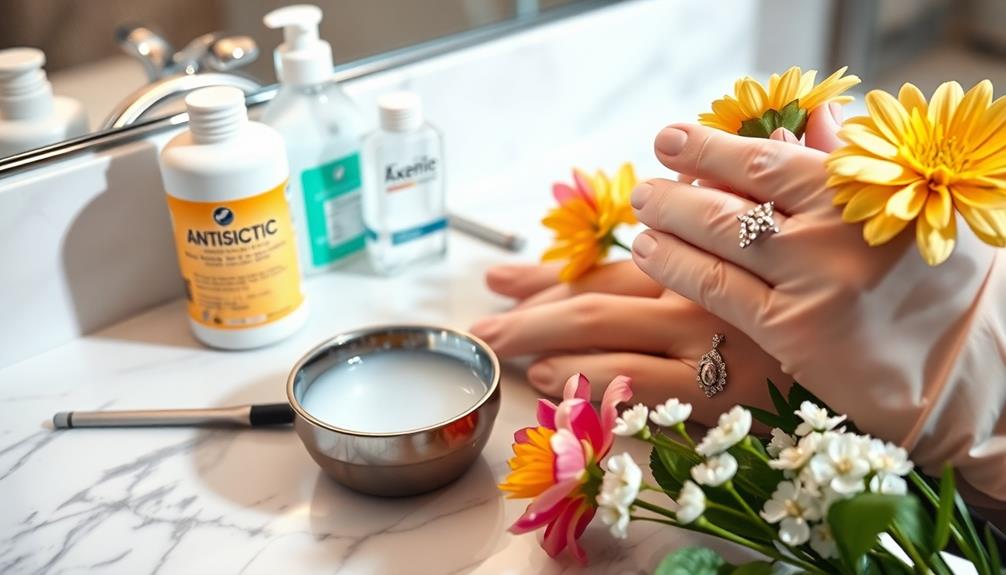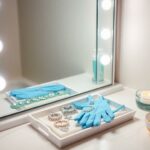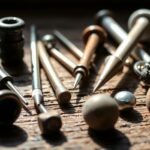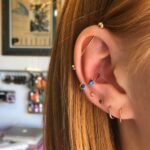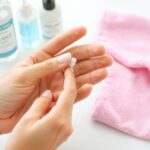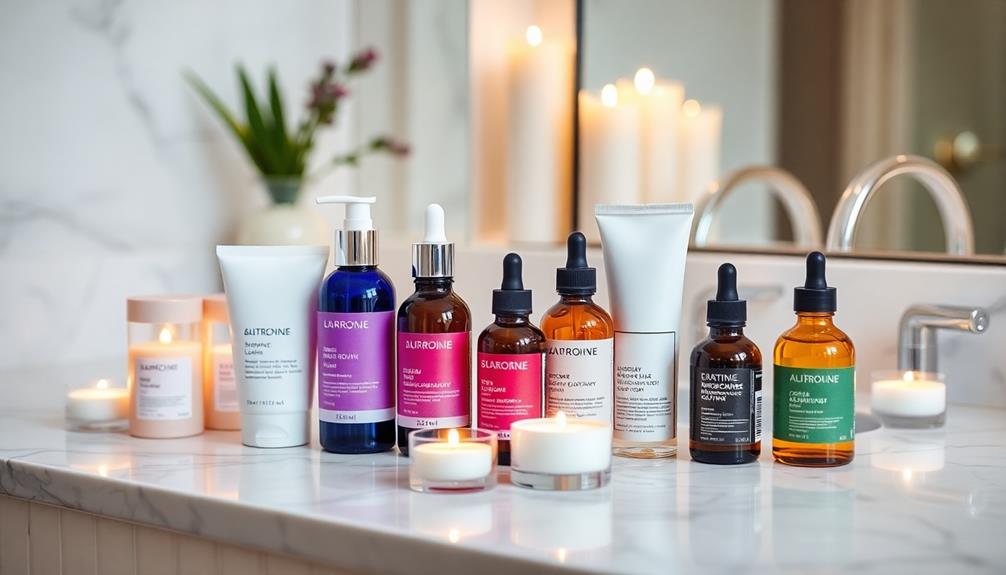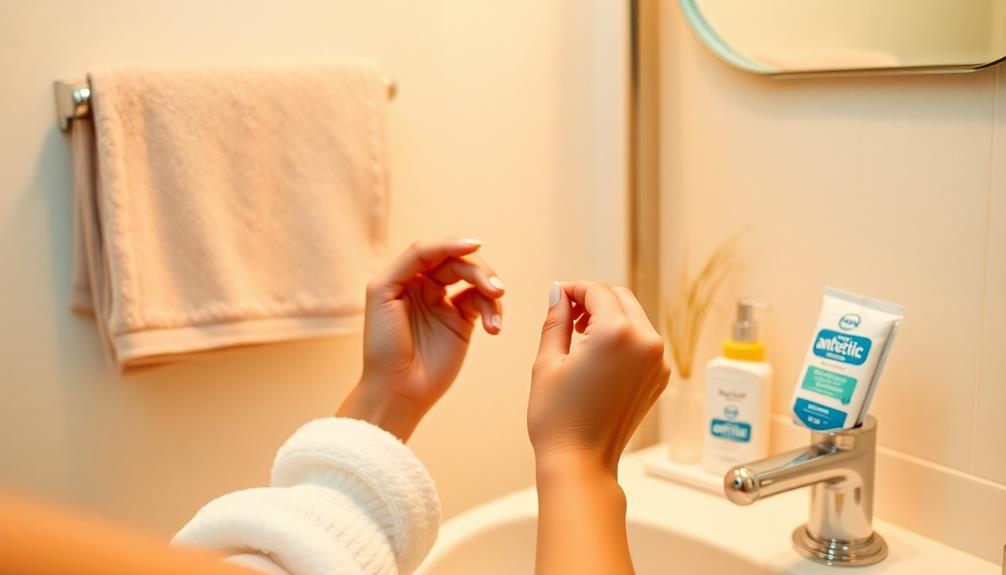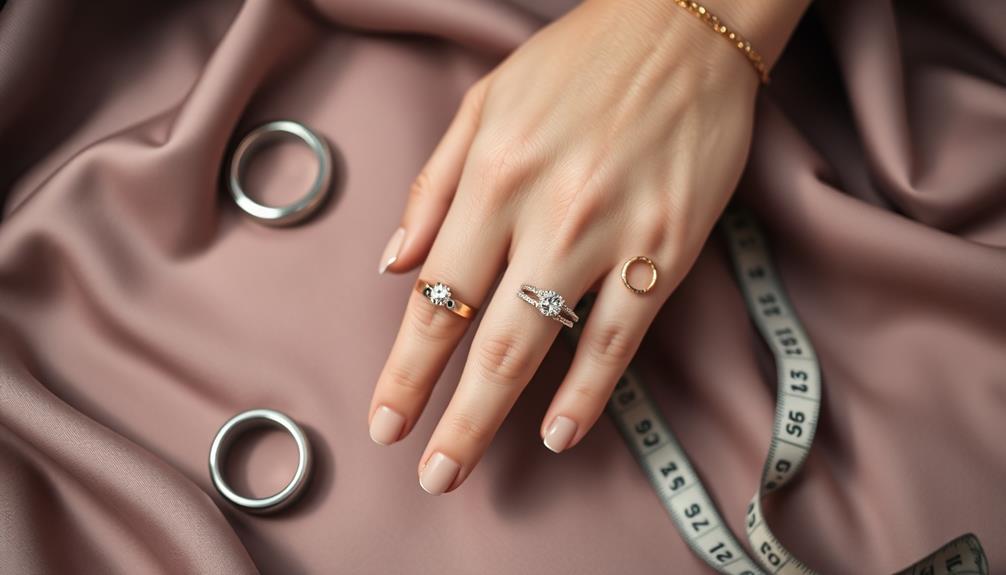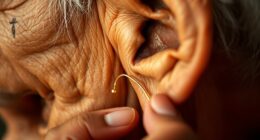Changing your piercing jewelry for the first time takes some caution. Verify your piercing is fully healed—usually six weeks for earlobes—or at least three months for cartilage. Start by washing your hands and using a saline solution to clean the piercing. Remove the old jewelry slowly, applying gentle pressure to avoid irritation. When inserting the new jewelry, choose hypoallergenic materials, like surgical steel or gold, to minimize discomfort. If you feel resistance, stop and consult a professional. For more tips on picking the right earrings and maintaining your piercings, check out the additional insights available.
Key Takeaways
- Ensure you have clean hands and a saline solution ready before attempting to change your jewelry.
- Gently clean the piercing to remove any buildup before removing the old jewelry.
- Remove the old jewelry slowly and carefully to avoid causing irritation or injury.
- Insert the new jewelry gently; if you feel resistance, stop and consult a professional.
- Choose hypoallergenic materials and lightweight designs to minimize discomfort during the healing process.
Healing Process Before Changing Jewelry
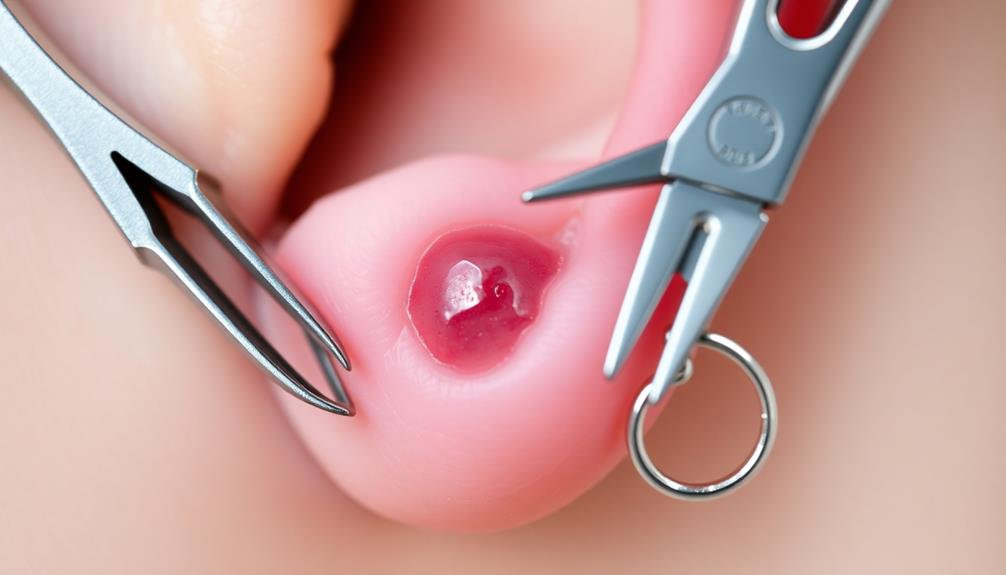
Before you think about changing your piercing jewelry, it's crucial to make certain your piercing is fully healed. Typically, ear lobes heal in about six weeks, while cartilage piercings can take three to six months or even longer.
To verify your piercing is ready for a change, look for signs of healing. Absence of redness, swelling, and pain indicates your piercing may be ready for new earrings.
During the healing process, regularly clean your piercing with a saltwater solution to promote healing and prevent infection. Use a mixture of 1/4 tsp salt in 250ml boiled water.
When you're ready to change your jewelry, opt for hypoallergenic metals like stainless steel to minimize the risk of infection or allergic reactions.
It's important not to change your earrings too frequently while your piercing is still healing. Frequent changes can cause trauma to the area and may lead to complications such as irritation or rejection.
Taking the time to verify your piercing is well-healed will help you enjoy your new jewelry without unnecessary risk.
Steps for Safe Jewelry Change

Once you've confirmed your piercing is fully healed, you can safely change your jewelry. Start by washing your hands and cleaning your ears to prevent introducing dirt or bacteria. Make sure your workspace is secure to avoid losing any jewelry during the process.
| Step | Action | Tip |
|---|---|---|
| 1. Wash Your Hands | Use soap and water to clean your hands. | Always prioritize hygiene. |
| 2. Clean the Piercing | Gently pull back the ear and clean it. | Use saline solution. |
| 3. Remove Old Jewelry | Apply gentle pressure to remove backs. | Avoid sudden movements. |
| 4. Insert New Jewelry | If it feels resistant or painful, stop. | Use a water-based lubricant. |
When you insert the new jewelry, take your time. If you experience resistance or pain, don't force it; consult a professional. Opt for high-quality jewelry to minimize irritation. Remember, if this is your first time, it's crucial to be patient and follow these steps carefully to guarantee a smooth and safe change.
Selecting the Right Earrings

Choosing the right earrings is vital for both comfort and style, especially after getting a new piercing. When selecting new earrings, prioritize hypoallergenic materials like surgical steel or 14K gold. These materials minimize the risk of irritation or allergic reactions during the healing process and can enhance overall skin health by preventing breakouts or irritation around the piercing site, as noted in the benefits of glycolic acid.
For cartilage piercings, opt for earrings with a thinner post thickness to avoid irritation, while a thicker post is better suited for healed lobes. Initially, go for lightweight options, such as mini huggie hoops or small gold hoops, to prevent unnecessary pressure on your healing piercings, particularly earlobes.
It's important to avoid heavy or chunky earrings for at least the first six months post-piercing. Doing so guarantees comfort and prevents complications while the area is still healing.
Once your piercing is fully healed, you can explore various styles, including drop earrings or hypoallergenic charms, to diversify your collection.
Always prioritize comfort and choose earrings that won't irritate your skin. With the right selection, you'll not only look great but also support the healing process of your new piercing.
Types of Piercing Jewelry

Piercing jewelry comes in a variety of styles, each tailored to different body parts and personal preferences. You'll find types of piercing jewelry like studs, hoops, barbells, plugs, and rings, each designed for specific uses. If you're changing your jewelry for the first time, starter earrings are often recommended for new piercings.
When selecting your jewelry, consider the gauge thickness, as it affects how well the piece fits in your piercing site. A slight difference in gauge can complicate the changing process, so make sure you choose the right thickness. Common materials include surgical steel and titanium, both hypoallergenic and suitable for sensitive skin, along with solid gold and acrylic options.
For easier changes, look for specialty types like internally threaded posts or segment rings, which minimize irritation.
Customization options, such as gemstone accents or unique designs, let you express your personal style while making certain of safety and comfort.
Care and Maintenance Tips
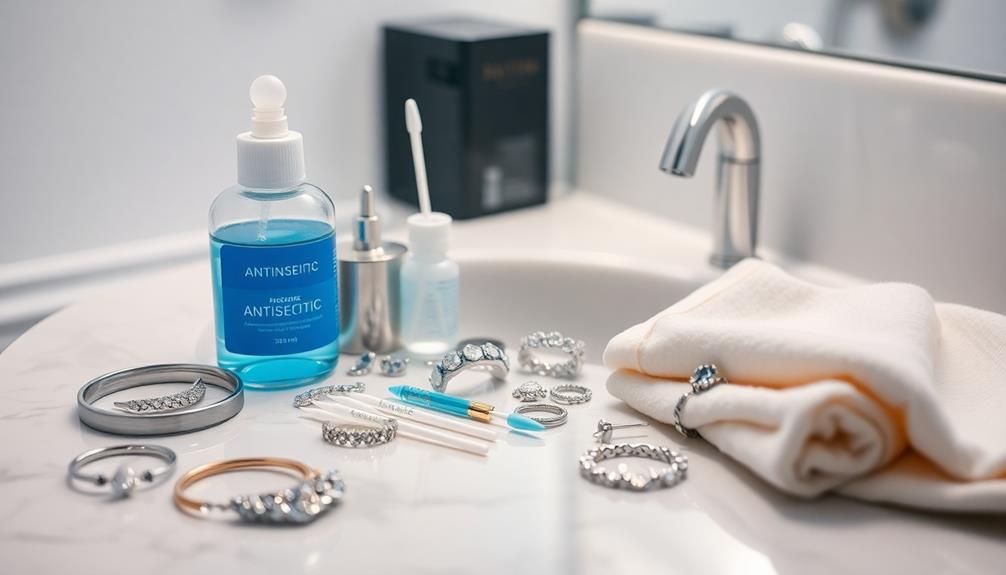
Taking care of your piercing jewelry is essential for both hygiene and longevity. Regular maintenance can markedly reduce the risk of infection and guarantee your jewelry remains in excellent condition. Start by cleaning your jewelry regularly with saline solution or antiseptic wipes. This simple step helps to maintain hygiene and promotes healing.
Store your jewelry in a clean, dry place to prevent tarnishing and damage. It's also important to inspect your jewelry frequently for any signs of wear or damage. Catching issues early can save you from serious problems down the line.
Follow the aftercare instructions provided by your piercer diligently to support the healing process. Avoid harsh chemicals during cleaning, as they can compromise the integrity of your jewelry materials.
Here's a quick reference table to help you with care and maintenance:
| Task | Frequency |
|---|---|
| Clean jewelry | 2-3 times a week |
| Inspect for damage | Weekly |
| Store properly | Every time you use |
Frequently Asked Questions
How Do You Change Piercing Jewelry for the First Time?
To change your piercing jewelry for the first time, make certain it's fully healed. Wash your hands, clean the area, and use lubricant if needed. Gently remove the old jewelry and replace it carefully.
How to Change Earring for the First Time?
Imagine gently unhooking a butterfly from its cocoon; you'll first wash your hands and ears, then carefully remove the old earring, and finally slide in the new one with a smooth, confident motion.
What Happens if You Change Your Piercing Jewelry Early?
If you change your piercing jewelry early, you risk trauma, irritation, and complications like piercing bumps or rejection. It's essential to wait until the piercing's fully healed to avoid these issues and guarantee proper healing.
Does It Hurt Changing Your Ear Piercing for the First Time?
Yes, it can hurt a bit when you change your ear piercing for the first time. If your piercing isn't fully healed, you might feel discomfort or resistance, so be gentle and patient during the process.
Conclusion
In summary, changing your piercing jewelry for the first time can be simple and safe if you follow the right steps. Remember, "a stitch in time saves nine"—taking care during this process can prevent complications later on. Always verify your piercings are fully healed, choose jewelry made from safe materials, and maintain proper hygiene. With these tips in mind, you can confidently switch up your style while keeping your piercings healthy and happy.
Hi, my name is Danielle, and I’m an author for piercings-body.com. I have a passion for writing and love to share my knowledge on all things body piercing-related. I’m also a huge advocate for safe body modification practices and believe everyone should be able to make informed decisions about their bodies. When I’m not writing or blogging, I enjoy spending time with my family and friends, practicing yoga, and exploring new places.

